General
The goal of the Prevention Department is: the prevention of inadvertent and deliberate doping infringements in Dutch sport. The main target groups are: elite athletes, athletes in sports organised outside a club context (fitness training in particular), support staff (principally trainers/coaches, sports doctors and GPs, physiotherapists, dieticians/sport dieticians, sports masseurs, parents) and the general public.
The activities include providing information about doping regulations, the risks of doping, proposing healthy and legitimate alternatives for enhancing performance, and efforts to establish or reinforce anti-doping attitudes among athletes and support staff.
The following items are addressed specifically during information meetings for elite athletes: the health risks associated with doping, the rights and obligations of athletes, the prohibited list, the doping control procedure, arrangements for therapeutic use exemptions, the whereabouts system, the risks of dietary supplements and the damage inflicted by doping to the 'spirit of sport', and the 100% Dope Free campaign.
Meetings for support staff cover these issues, but also focus on the rights and, in particular, the duties of support staff, as well as factors that exacerbate or mitigate the risk of doping.
With the fitness training target group, the emphasis is on guest classes during the numerous fitness training courses. These classes look at the different types of doping, the risks of use, the way the substances work and the side-effects, fact and fiction relating to supplements, doping prevention and the Own Strength campaign.
The Doping Authority's four sites (the corporate site www.dopingautoriteit.nl, and the sites www.100procentdopefree.nl, www.eigenkracht.nl and www.doping.nl) are important channels for communications with the various target groups. In addition, athletes, fitness athletes, and support staff use the Doping E-mail Line (since 2012, questions can only be asked by e-mail).
New legislation relating to cookies meant that it was not possible to record visitor statistics for the entire year. Those figures have therefore not been included in this annual report.
Elite sport
Elite sport campaign 100% Dope Free
Many existing activities focusing on Dutch elite sport have now been transferred to the elite sport campaign, 100% Dope Free. The campaign is based on the survey of Dutch elite athletes conducted every four years. That survey showed that the vast majority of elite athletes are opposed to doping. In addition to providing information, this campaign focuses on changing attitudes and behaviour.
www.100procentdopefree.nl
The campaign's site plays a central role: all information about the campaign can be found there. Twenty-four news flashes appeared in 2012 and five newsletters were sent to all the subscribers (numbering approximately 14,000).
100% Dope Free - True Winner
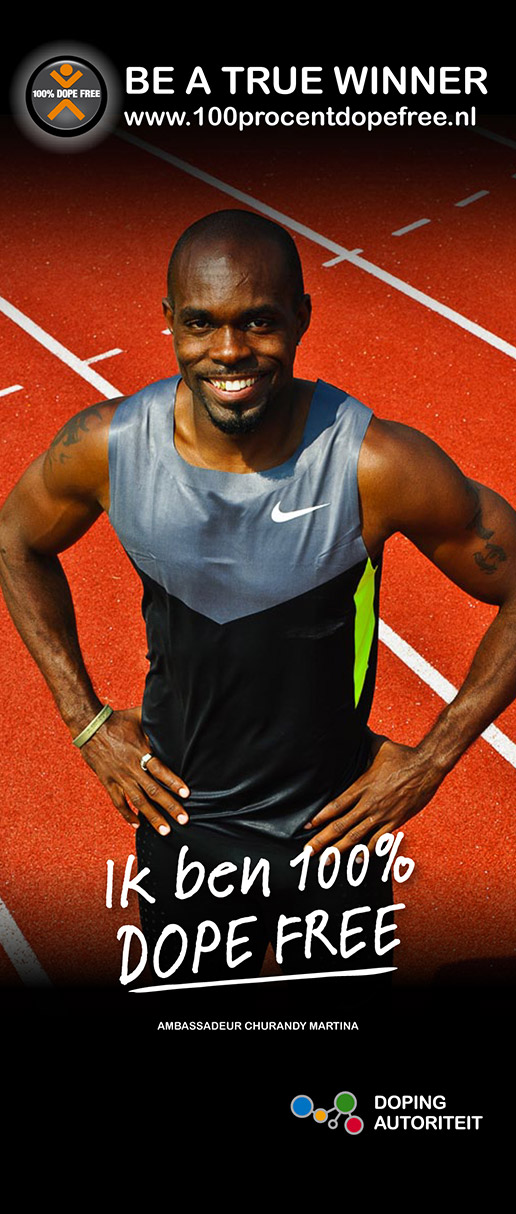
This part of the campaign (which began in December 2007) gives elite and competitive athletes the opportunity to sign an anti-doping statement and to adopt an active stance against doping. Once they have signed the statement, the athletes are sent the gold wristband to symbolise the fact that you are only a true winner if you perform without doping. In 2012, the number of statements increased from more than 23,000 to more than 25,000.
This part of the programme was developed and implemented in collaboration with the NOC*NSF Athletes Committee. Femke Dekker (rowing), Rutger Smith (athletics), Jokelyn Tienstra (handball), Carl Verheijen (speed skating), Richard Bottram (marathon 365 & Wheel of Energy), Epke Zonderland (gymnastics), Mirjam de Koning-Peper (swimming), Thijs van Valkengoed (swimming), Churandy Martina (athletics) and Marianne Vos (cycling) are the ambassadors for the campaign. In 2012, Vince Smoke (baseball) joined the ranks, and his contribution included a video on the site. Roll-up banners were produced for six ambassadors.
Information meetings
Members of the National Testing Pool (NTP) are required to attend one Doping Authority information meeting a year. This can be arranged through the sports associations but collaboration is mostly with the Olympic Support Centres. In total, there were 47 information meetings for elite athletes and their immediate support staff.
In 2012, online information was organised for elite athletes for the second year. The latest elite sport survey (2010) showed that athletes very much want to be informed digitally. In 2011, 103 athletes studied the online information and appreciation levels were high. In 2012, this number was much lower: 32.
Outreach Events

There were seven outreach events in 2012. The idea is to deliberately target events/competitions, where large groups of athletes (particularly young and talented athletes), but also their parents and trainers/coaches, are given general information and where they can put questions to the Doping Authority. There is also an opportunity to sign the 100% Dope Free – True Winner statement. By completing the WADA doping quiz, it is possible to win an incentive. Outreach events were organised at: National Indoor Athletics Championships, the KNSB Jubilee, National Youth Tennis Championships and Regional Championships, World Basketball Championships (woman under 17), World Cycling Championships (road race), the KNWU Cycling Day and the ISU World Cup (jointly with the ISU).
Doping fan booklet
A doping ban booklet appeared again in 2012, this time with the theme Talent against Doping. It contains the main doping rules, the WADA prohibited list, the list of common approved medicines (classified according to symptoms), and an explanation of the doping control procedure. In early January, when the new prohibited list came into force, the fan booklet was sent to all A and B athletes and 'High Potentials' designated by the NOC*NSF. In addition, all sports doctors, the members of the TUE committee and the Doping Authority's press contacts received a fan booklet. Elite sport organisations and Olympic Support Centres were also asked to distribute the booklet to athletes and support staff. In addition, the doping fan booklet was handed out during information meetings, outreach events and at fairs. DCOs take booklets with them for handing out during doping controls. The doping fan booklet can also be purchased separately.
Stay Negative! Folder
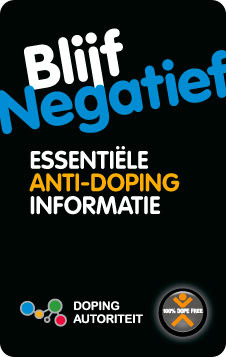
2012 saw the publication of a small compact folder entitled Stay Negative! The aim of the leaflet is to inform large groups of athletes who may qualify for doping controls about the main risks that can lead to inadvertent doping infringements. The folder was distributed through all the sports associations, Olympic Networks, all Sport Medical Institutions (SMIs) and all Professional Football Organisations (BVOs).
Articles
A topical doping subject is discussed every month in the NOC*NSF elite sport magazine Lopend Vuur. Eight articles were published in 2012.
100% Dope Free videos
In 2012, a video was produced with ambassador Churandy Martina in addition to the video with Vince Rooi.
Advertisements

The 'Be True' advert was used to generate publicity for the campaign. It calls on athletes to sign the 100% Dope Free – True Winner statement and to support the campaign. This advertisement was published in 2012 in various sports magazines.
Meeting of sports associations
A meeting was organised for the third time for the staff of sports associations (Together against doping). It took place on 11 November in Nieuwegein and was attended by 40 people from both sports associations and Olympic Support Centres. The aim was to improve collaboration and, in that way, to educate as many elite athletes (or up-and-coming athletes) as possible before they undergo their first doping control. The aim is to organise an association meeting of this kind every year. The subjects covered in 2012 included recent developments in the doping policy, the latest information about our elite sports plans, how disciplinary proceedings are conducted and an evaluation of the prevention policy.
Developments
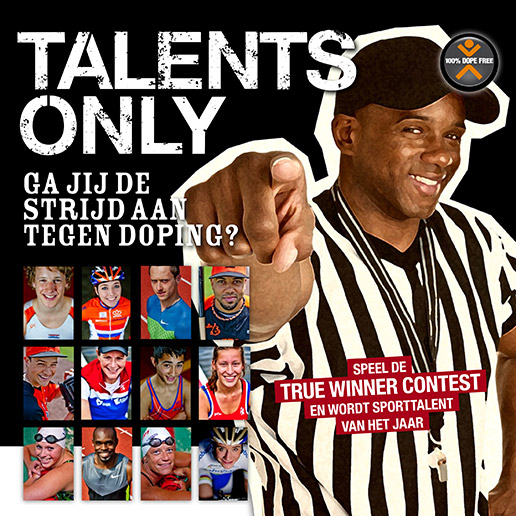
Doping educational activities are focusing increasingly on talented athletes (International Talent, Dutch Talent, High Potentials). In this context, work continued in 2012 on a project for promising athletes: Talents Only. As well as a brochure, it will also include information and videos on the site. Talents Only will be launched in the spring of 2013.
Therapeutic Use Exemption Committee (TUE committee)
The therapeutic use exemption arrangements were relaxed slightly again in 2012. Exemptions for widely-used b2 agonists such as salbutamol and salmeterol had already been dispensed with; from 1 January 2012 onwards, this was also the case for inhaled formoterol.
In the end, exemptions were granted in 82 cases. Only one application was refused.
| 2009 | 2010 | 2011 | 2012 | |
|---|---|---|---|---|
| Granted | 278 | 140 | 111 | 82 |
| Refused | 48 (14.7%) | 12 (7.9%) | 8 (6.7%) | 1 (1%) |
Most exemptions in 2012 related to the use of methylphenidate (35%; the same percentage as in 2011). Other medication for which exemptions were often granted included prednisone (24%, 11% in 2011) and insulin (12%, 5% in 2011).
Taken as a whole, the applications came from 21 different sports associations, ten fewer than in 2010. Most applications this year were, once again, from the Royal Dutch Cycling Union (KNWU, 21%) and the Royal Netherlands Swimming Association (KNZB, 15%). Three associations accounted for 7% of the applications: the Dutch Judo Association (JBN), the Athletics Union and the Royal Netherlands Skating Association (KNSB).
Sports organised outside a club context
Own Strength campaign
The main target group in sports organised on alternative lines consists of: visitors to fitness centres and their immediate circles (particularly fitness instructors). The Own Strength campaign was developed for this group. The campaign material includes: a poster for men and women, an Own Strength container (in different sizes), a display with leaflets, a T-shirt, a water bottle and a DVD. The campaign was promoted in a range of fitness magazines and during educational activities, and there is a promotional leaflet. In late 2012, 171 fitness centres were participating in the campaign.
To generate additional interest in the Own Strength campaign at fitness centres, a 'winter campaign' was launched in December 2012, continuing through January and February of 2013. The campaign consisted of additional web postings on the www.eigenkracht.nl site, an announcement about the campaign on the site, an advertisement in Fit!Magazine and a mailing campaign targeting more than 800 fitness centres that are members of Fit!vak. A telephone campaign was also initiated to encourage fitness centres to use the educational materials provided by Own Strength and, in that way, to be included on the list of Own Strength Centres (on the website). That resulted in 30 new centres, raising the total number of participating centres to 171. A telephone campaign was launched in February 2013 to determine what visitors to the participating fitness centres think about the materials. There will be a report on the survey in late March.
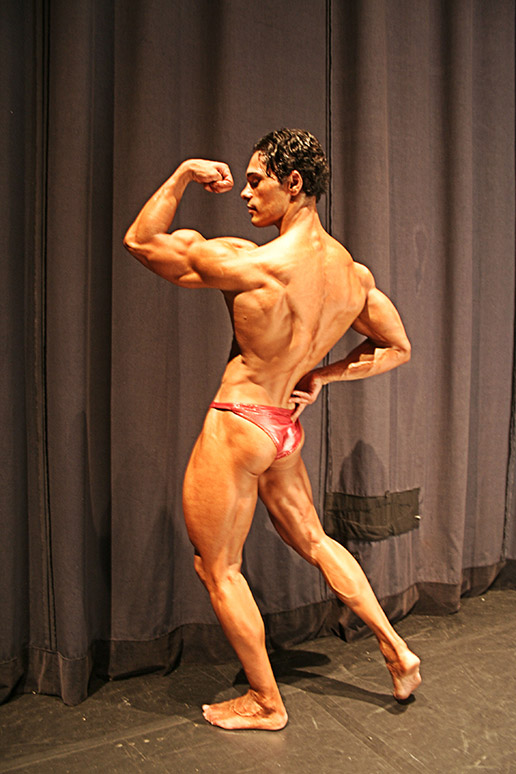
The Own Strength site plays a central role in the campaign. Alongside text, videos are being used more and more. In addition, there are four full annual programmes for four different training goals. The site has also been made more user-friendly by classifying postings under headings such as training, diet, supplements, doping, health etc. This makes it easier for visitors to find extensive information about specific topics.
The site specifically targets athletes/cosmetic athletes in fitness centres. It provides objective, clear and practical information about how to build up muscle mass cleanly and effectively, and about sound ways of losing weight. There is also objective information about various types of listed prohibited substances and the side-effects, as well as a wide range of information about the Own Strength campaign.
In 2012, a total of 56 factual news reports were posted on the site. They were written by three external experts (journalists or specific experts) from the fitness/body-building branch and by our own prevention officers. One was a press release from the Dutch Food and Consumer Product Safety Authority (NVWA) relating to the ban on methylhexanamine.
Videos
Own Strength uses videos more and more. Ten instruction and expert opinion films were produced in 2012. Five of them have now been posted on the site. The other five are still being processed.
Fitness courses & meetings
In 2012, the Own Strength campaign included about 15 guest lessons at numerous educational institutes and private fitness courses. The Own Strength water bottle was handed out during those lessons to trainee fitness instructors. There were also presentations on three occasions at fitness conferences.
Clean Hunks
Clean Hunks are fitness athletes/body builders who have demonstrated that you can build up an impressive physique without dope. There are twelve of them in all. They are all on the site, which includes background stories and photos. Others can follow their example and join the campaign.
Articles
Since 1997, Own Strength has had a regular column in the popular bodybuilding magazine Sport & Fitness Magazine. Acting under its own editorial responsibility, the Doping Authority provides objective information in each issue about prohibited substances and related matters. All the published articles are also posted on www.eigenkracht.nl so that the information remains available. The publication was suspended in 2011 but it started again in 2012. Four articles were published in 2012.
Two articles were also published in Fitness Expert and contributions have been made to other magazines.
Advertisements
The advertisement for men from the Own Strength campaign was published in all the 2012 issues of Sports & Fitness.
Steroids clinic
Cosmetic athletes with medical complaints or questions were regularly referred to the steroids clinic in the Kennemer Gasthuis hospital in Haarlem. These issues were also part of the standard coverage in our own article in Sport & Fitness. In 2012, Sport & Fitness devoted a complete article to the Steroids Clinic.
Collaboration with the fitness branch
On 22 April 2012, the Doping Authority and Fit!vak signed an agreement to collaborate more and in more concrete ways to combat doping in fitness centres. The Doping Authority and Fit!vak meet every six months to discuss progress.
In the context of a European project Fitness against Doping, we teamed up with the Europe Health and Fitness Association (EHFA), the coordinator of this project. It has also been agreed with the EHFA that there will be more collaboration with the aim of establishing a better doping prevention policy. We participated in an EHFA Technical Expert Group for Anti-Doping.
Book: Doping, the sober facts
The booklet Drug Info, doping. Hard facts about doping was published in 2000. It is now out of date and so work has started on a new, improved edition. Extensive research and a lot of writing went into this new book in 2011 and 2012. It will be published in 2013.
European project Strategy for Stopping Steroids
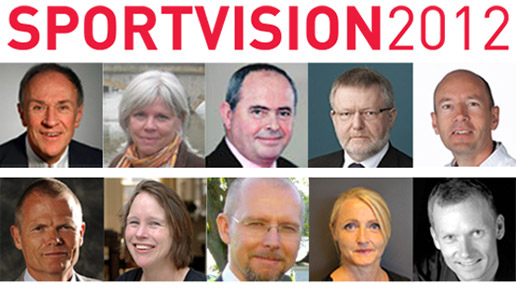
Anti-Doping Denmark obtained a subsidy from the European Commission with four other countries (Sweden, Cyprus, Poland and the Netherlands) for a project bringing together knowledge and experience from different countries with the aim of optimising the strategy to stop steroids. The project started in April 2011 and ended with a congress on 19 and 20 March 2012 in Copenhagen. The findings from the project have been described in a report.
Following up on the alliance, the Swedish project partner (STAD) went on a working visit to the Doping Authority on 13 September.
Support staff
In addition to the focus on athletes, there has been an increasing emphasis in recent years on a range of athlete support staff. They can play an important role in both a positive and negative sense. Trainers and coaches in particular play a prominent role. Sports doctors and paramedics are also important.
Brochure for Support Staff
The brochure, entitled About support: how parents, trainers, coaches and other support staff can contribute to dope-free sports was distributed widely again at information meetings, training and refresher training and outreach events. In 2013, the brochure will be revised and reprinted in the 100% Dope Free house style.
In December 2012, the Stay Negative! folder was distributed with the NL Coach magazine (8,000 copies).
Trainer/coach courses
In collaboration with the NOC*NSF Academy for Sports Administrators and a number of sports associations, a general module was produced for levels 3 and 4 of coach courses, including an e-learning module covering a range of different sports that is suitable for both level-3 and level-4 coach courses. This e-learning module consists of a teaser/introduction, a knowledge test, four dilemmas and a section The golden path that requires the right decisions to be taken at different points and that also supplies feedback. In 2012, the generic module for level 3 was taught once. The videos made for this module are also used in other coach courses.
Presentations and outreach events
There were presentations at a range of courses and refresher courses, such as the Sports Physiotherapy masters course, two Sports Nutrition coaches, cycling union courses for team managers, soigneurs and level-4 coaches, the Sports Management minor of the Dutch Hogeschool for Tourism and Leisure, Sports Psychology of the Radboud University Nijmegen, the skating union course for level-4 coaches, the table tennis association coaching course (level 4), and the boxing association coaching course (level 3). There was also an outreach event during the National Coach Congress on 14 December.
General public
www.dopingautoriteit.nl
The overhauled corporate website went online in February 2012. The site has undergone extensive revision and extensions and it offers new functionalities. ANP news releases make up an important part of the topical information on the site. They are posted immediately after release. A total of 601 ANP news releases were published on the site in 2012 (after correction for revised releases). We contributed 26 releases of our own to the site in 2012.
In addition to current news about doping, the site contains general information about the prohibited list, about the campaigns being conducted by the Doping Authority and about our own organisation. Athletes can turn to a separate service section to apply for exemptions, and there is a section where elite athletes can submit whereabouts information. The site also houses the Dutch dietary supplement database.
Doping E-mail Line
The Doping Infoline is the front office of the Doping Authority, manned alternately by four operators. The telephone service was shut down with effect from 1 January 2012 and the service is now available exclusively by e-mail. The name has therefore been changed to the Doping E-mail Line. All substantive questions are processed every working day and recorded anonymously in a database.
In 2012, the total number of e-mails was 995, which compares with the total of 941 e‑mails and phone calls in 2011. This is an increase of 6%. See the table for all the figures.
| Category | 2012 | 2011 | Difference (%) |
|---|---|---|---|
| Total number of e-mails | 995 | 530 | + 465 (+88%) |
| Number of e-mails per working day | 4.0 e-mails | 2.1 e-mails | + 1.9 (+90%) |
| Percentage men | 57% | 55% | +2% |
| Percentage women | 43% | 45% | -2% |
| Background | 1 Unknown (49.9%) 2 Athlete (27.0%) 3 School pupil (6.0%) 4 Other (4.7%) 5 Parent (3.4%) 6 Trainer/coach/support staff (2.9%) 7 Doctor (2.9%) 8 Association employee (2.0%) 9 Physiotherapist (0.8%) 10 Partner (0.1%) 11 Family/acquaintance (0.1%) |
1 Unknown (35.8%) 2 Athlete (34.9%) 3 School pupil (8.9%) 4 Parent (7.2%) 5 Other (4.2%) 6 Trainer/coach/support staff (3.4%) 7 Association employee (2.8%) 8 Doctor (1.1%) 9 Physiotherapist (0.8%) 10 Partner (0.8%) 11 Family/acquaintance (0.2%) |
|
| Percentage elite athletes | 84.3% | 75.7% | +8.6% |
| Percentage grassroots athletes | 15.7% | 24.3% | -8,6% |
| Top-five doping categories | 1 Glucocorticosteroids (26.2%) 2 Anabolic substances (20.0%) 3 Stimulants (17.7%) 4 B2 agonists (13.1%) 5 Peptide hormones etc. (6.9%) |
1 Anabolic substances (38.8%) 2 Glucocorticosteroids(19.0%) 3 B2 agonists (15.5%) 4 Stimulants (11.2%) 5 Peptide hormones etc. (8,6%) |
|
| Top-five questions | 1 Prohibited list (26.9%) 2 Supplements (21.8%) 3 TUE (8.2%) 4 School project (7.0%) 5 Doping control (5.0%) |
1 Prohibited list (25.7%) 2 Supplements (24.5%) 3 TUE (9.5%) 4 School project (8.6%) 5 Action & risks (7.8%) |
|
| Branch of sport | 1 Unknown (70.5%) 2 Fitness (4.9%) 3 Cycling (4.6%) 4 Athletics (1.9%) 5 Baseball and softball (1.6%) |
1 Unknown (63.2%) 2 Fitness (8.9%) 3 Cycling (4.2%) 4 Swimming & Athletics (3.0%) |
|
| Referral | 1 Doping Authority site (32.8%) 2 NZVT (Dietary supplements) (19.8%) 3 100% Dope Free website (12.8%) 4 Internal (10.9%) 5 Own Strength website (9.4%) |
1 Doping Authority site (30.7%) 2 NZVT (Dietary supplements) (22.6%) 3 Own Strength website (17.8%) 4 100% Dope Free website (9.4%) 5 Other (5.9%) |
|
| Day by day: Monday Tuesday Wednesday Thursday Friday |
23.7% 23.9% 16.4% 19.7% 16.3% |
29.2% 21.3% 20.9% 16.0% 12.5% |
-5.5% +2.6% -4.5% +3.7% +3.8% |
| Month by month January February March April May June July August September October November December |
6.8% 10.3% 11.0% 7.9% 8.7% 8.0% 7.6% 6.2% 6.3% 9.7% 10.6% 6.7% |
9.6% 9.4% 10.0% 7.2% 8.9% 8.1% 5.3% 5.5% 5.1% 10.2% 8.9% 11.3% |
-2.7% +0.9% +1.0% +0.7% -0.2% -0.1% +2.3% +0.7% +1.2% -0.5% +1.7% -4.6% |
Press contacts
Every year, there is a press conference for the national media. This year, it was organised on 4 December 2012.
Twenty-six press releases were published during the course of the year.
There were also more than 500 individual contacts with the media, both print and broadcast.